#monotreme
Text
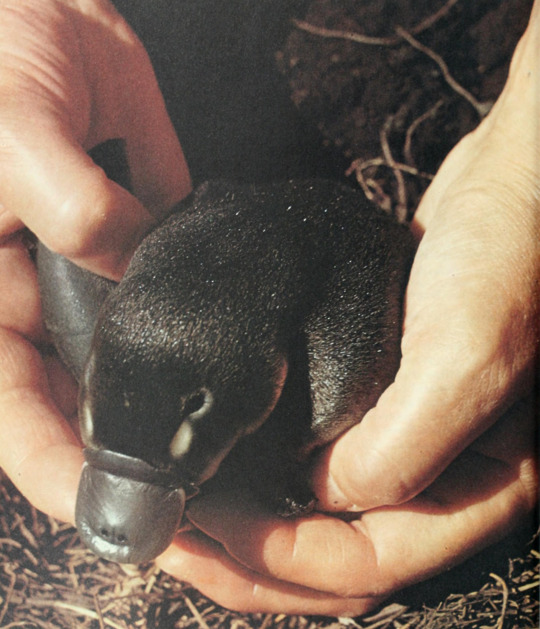
Baby platypus
By: Unknown photographer
From: Disney's Wonderful World of Knowledge
1971
12K notes
·
View notes
Text
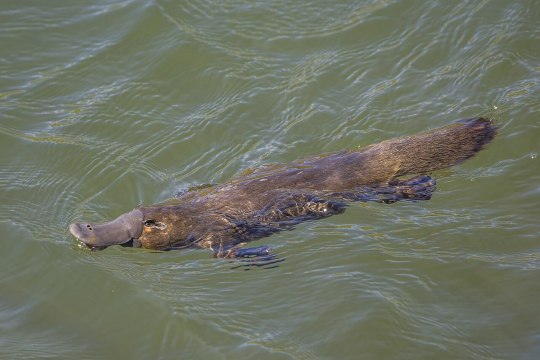
The World’s Oldest Wild Platypus Shocks Scientists at 24 Years of Age
The animal was tagged in 2000, when it was estimated to be about one year old, and re-discovered alive in the wild last year.
When Geoff Williams found and tagged a one-year-old male platypus as part of a survey in November 2000, he probably didn’t anticipate ever seeing the animal again.
But more than two decades later, in the same creek system in the suburbs of Melbourne, Australia, scientists found the platypus once again. When Williams then studied the creature, it was an unlikely reunion—and one with historic significance: At about 24 years old, the platypus is the oldest ever to be documented in the wild...
Read more: https://www.smithsonianmag.com/smart-news/the-worlds-oldest-wild-platypus-shocks-scientists-at-24-years-of-age-180983805
photograph by Charles J. Sharp
1K notes
·
View notes
Text
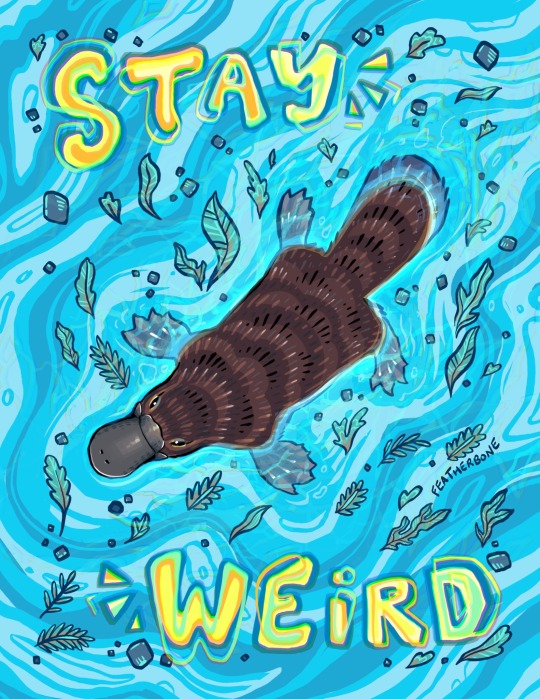
Always remember to stay weird!
[ID: an illustration of a platypus swimming in swirly blue water surrounded by pebbles and aquatic plants. Above and below it, the words “Stay weird” are drawn in teal, yellow, and orange, and there is a chromatic aberration effect which gives the words and water ripples a trippy vibe. End.]
3K notes
·
View notes
Text
Wonderful news from the Cyclops Mountains of West Papua today with the rediscovery of Attenborough's long-beaked echidna (Zaglossus attenboroughi)!

(Image credit: Expedition Cyclops)
Previously known a single specimen collected in 1961, Attenborough's long-beaked echidna has long been one of the world's most elusive mammals. Recognised as a distinct species in 1998, an expedition to the Cyclops Mountains in 2007 failed to observe the echidna but found evidence of recent diggings and foraging activity which, alongside local knowledge, implied that the species still survived in those remote mountain forests.
Finally, just a few months ago, a new expedition into its remote mountain home by Expedition Cyclops caught the first ever footage of Attenborough's long-beaked echidna in the wild, which is also the first time it has been seen by scientists in over 60 years. In a remarkable stroke of luck, the echidna was captured on the last of over 80 camera traps on the final day of the trip!
Attenborough's long-beaked echidna is the most distinctive of the three species of long-beaked echidna thanks to its smaller size, shorter, straighter beak and reddish-brown fur. Its habits are virtually unknown, but its differently shaped beak may suggest that it differs in diet and feeding habits from the other two long-beaked echidna species. It appears to be endemic to the highest elevations of the Cyclops Mountains, which are steep, extremely rainy and treacherous to explore, hence why it remained hidden for so long.

(Image credit: Expedition Cyclops)
There are only five species of monotreme alive today, the sole living custodians of a lineage stretching back some 200 million years, and this makes each species extraordinarily valuable. Unfortunately, all three species of long-beaked echidna are threatened with extinction, with Attenborough's long-beaked echidna being classed as critically endangered. Losing any species is a tragedy, but for a group as small and precious as monotremes, any extinction would be especially disastrous.
Alongside the rediscovery of the echidna, Expedition Cyclops also made the first record of Mayr's honeyeater (Ptiloprora mayri) in 16 years and discovered dozens of new species of insects, arachnids, shrimp and frogs. Their work documenting the hidden biodiversity of the Cyclops Mountains is ongoing, so if you'd like to follow and support the expedition make sure to visit their website!
https://www.expeditioncyclops.org/
#oceania#papua#west papua#new guinea#wildlife#mammal#mammals#monotreme#monotremes#echidna#echidnas#animal facts#animal news#mammalogy#natural history#my stuff
288 notes
·
View notes
Text
At the Prehistoric Planet watch party last night, someone made a really interesting point: if a maniraptoran dinosaur had survived to the present day, we'd almost certainly think of them as the bird equivalent to monotreme mammals. They wouldn't be seen as a different group - they'd be 'those weird birds with the teeth and tails who can't fly'. The same way you'd never classify a platypus or an echidna as anything but a mammal - just a rather peculiar one with a bunch of strange primitive traits - our definition of bird would just be a bit wider.
In fact, the common ancestor of dromaeosaurs and birds lived more recently than the common ancestor of monotremes and other mammals!
#evolution#palaeoblr#bird#dromaeosaur#monotreme#also this sounds like a really cool world#vicky's vritings
660 notes
·
View notes
Text
Great news for monotreme lovers!!!

The Sir David Attenborough's Long-Beaked Echidna (Zaglossus attenboroughi) has been sighted for the first time since 1961!
Also known as the Cyclops Long-Beaked Echidna, this nocturnal critter was first described by Western scientists in 1961 during the Dutch colonial era of what was then known as Dutch New Guinea. It was only described from a fragmentary preserved specimen (pictured below) and was of course named after the famous naturalist Sir David Attenborough. However, I do want to point out that, as is the case with many newly discovered species, it was known to the native people of this region way before this and was traditionally hunted for both food and for ceremonial peace offerings. However, according to my research since the species was classified as Critically Endangered, the native villagers were very enthusiastic about its conservation and agreed not to hunt them in order to help preserve the species.

Z. attenboroughi is native to the Cyclops Mountain Chain in northern Indonesian New Guinea and feeds mostly on worms, ants, termites, and other invertebrates by using their long beaks to forage through the soil and creating distinct “nose pokes”. For a long time, these “nose pokes” were the only sign scientists had that this species hadn’t gone extinct. The last unconfirmed sighting by locals was in 2005, though some tracks and burrows that were thought to belong to the species were discovered in 2007.
Now, over 60 years after it was initially described, an expedition of scientists from Oxford University to the Cyclops Mountains has resulted in this elusive monotreme being videotaped by a game trail camera.

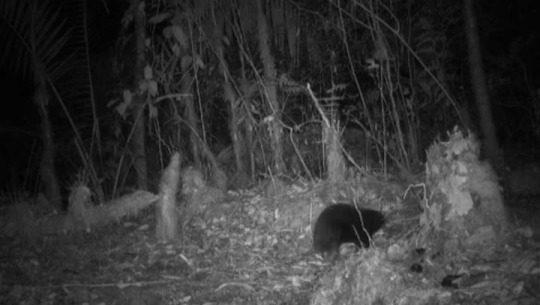
Photo credit: Cyclops Expedition
Attenborough’s Long-Beaked Echidna might somewhat resemble hedgehogs in appearance and behavior, however, they are one of only five species of egg-laying mammals known as monotremes! The other four species are the Short-Beaked Echidna, Western Long-Beaked Echidna, Eastern Long-Beaked Echidna, and the Platypus. The Attenborough’s Long-Beaked Echidna is the smallest species of Echidna and is apparently more closely related to the Short-Beaked Echidna than it is to the other two species of Long-Beakeds. It also possesses a more reddish coloration. All species of monotremes are known for, as I mentioned before, laying eggs instead of giving live birth like placental mammals and marsupials do. Monotremes also lack nipples and instead produce milk for their young out of modified sweat glands like how the early ancestors of all mammals did. Male Platypi/Platypuses (both terms are correct) and Echidnas also have ankle spurs which are highly venomous in the case of the Platypus, but Echidnas seem to have lost their venom and instead use them to help dig. Apparently, they also seasonally secrete a creamy substance their spurs but this, while kinda gross, is harmless.
While the rediscovery of this species is super exciting, we mustn’t forget that Attenborough’s Long-Beaked Echidna is considered Critically Endangered and is still at risk of extinction. Habitat loss and poaching seem to be the biggest threats to this species and many other unique creatures endemic to Oceania.
#monotreme#echidna#new discoveries#critically endangered#science#infodump#animals#endangered species#new guinea#animal news
178 notes
·
View notes
Text
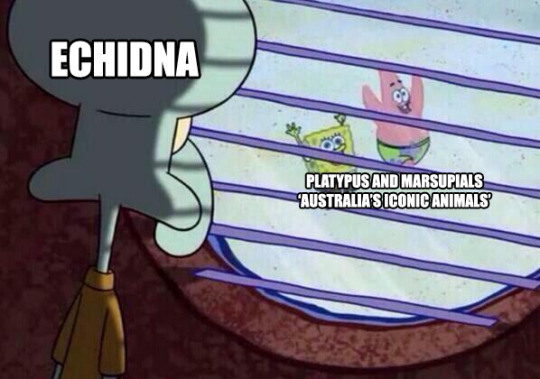
reblog if you support the humble echidna
#LISTEN#echidna#are adorable and weird and perfect#australia#wake up to your awesome lil pincushion#monotreme#marsupials#platypus#animals#animal awareness#rare animals#exotic animals#endangered animals#spreading the echidna propaganda#echidnas#mammals#mammalia#zoology
101 notes
·
View notes
Text
Wet Beast Wednesday: platypus
Since I've been designing original Pokemon for a hypothetical Australia-based region I've been doing some research on Australian fauna and one of them (which I made into a starter) is the famous platypus. Join me and we will learn why these animals are so weird I don't blame the European naturalists who thought they were hoaxes until presented with a live specimen. I mean you can blame European scientists of the time for a lot of things, but doubting the platypus isn't one of them.
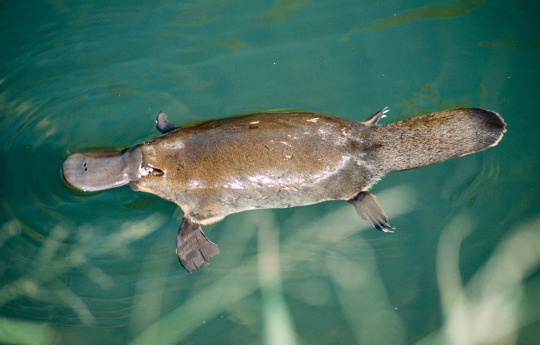
(image: a platypus at the surface of the water, seen from above. It is a brown, furry mammal. Its legs are very short, with long webbed tows. Its tail is broad, flat, and furry. It has a large duck-like bill at the front)
The first preserved Platypus specimens brought to Europe were thought to be hoaxes made by taxidermists attaching parts of different animals together, like the Fiji mermaid or jackalopes. Its pretty clear why they thought this as platypi (there's not definitive plural of platypus and platypi is the one I refer) look like real-life chimeras. A mole-like body (indeed, they were originally thought by naturalists to be species of mole) with a duck's bill, otter's feet, and beaver's tail. In fact, platypi are none of the above but are instead one of five surviving species of monotremes, the smallest and most basal lineage of extant mammals alongside the marsupials and placentals. Monotremes possess many traits distinct from other mammals and taxonomists currently believe that the monotreme lineage split off from the lineage of live-birth giving mammals prior to marsupials and placentals diverging from each other. Differences that monotremes have from all other mammals include a lower body temperature, lack of external ears, different jaw and inner ear structures, a cloaca (combination of the excretory and reproductive tracts into a single hole), more reptile-like embryo development, and the fact that they lay eggs instead of giving live birth. Many of these traits (especially the cloaca and laying eggs) are believed to be holdovers from pre-mammalian ancestors and thus monotremes are highly valued by scientists studying mammal evolution.
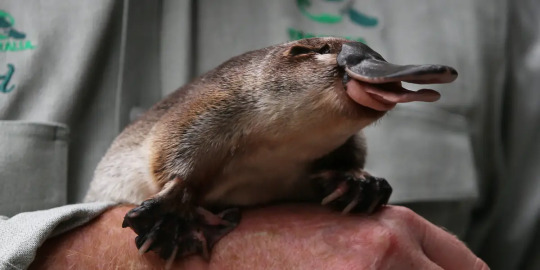
(image: a platyus standing on a person's hand. It is around the same size as the hand. It is seen from the front, with its head turned to the right. Its mouth is slightly open)
Platypi are semi-aquatic animals found in rivers and streams along eastern Australia and Tasmania. They are the only living members of their genus and family, though fossil relatives have been found. Their size varies based on habitat and ranges from 0.7 to 2.4 kg (1.6 to 5.3 lbs). Males average 50 cm (20 in) and females average 43 cm (17 in). Platypi are covered in fur that traps a layer of air to insulate them while swimming. The fur is bioflourescent, producing a blue-green glow when exposed to ultraviolet light. The tail is used to store fat and will glow larger in a well-fed individual. All four feet are webbed, the front feet more so. The style of swimming used by platypi is unlike that of any other amphibious or aquatic mammal. Other mammals use their hind feet and/or tails for propulsion. Platypi instead use their front feed for propulsion. The hind feet and tail are only used for steering. When on land, platypi curl up their front toes and walk on their knuckles to protect the webbing between their toes. The eyes are small and weak and are not used when hunting.

(image: a platypus seen from above and below, fluorescing under black light. Its top looks dark blue with splotches of purple while the underside is a lighter green-blue with purple towards the middle)
The bill is the most important organ for finding prey. All living monotremes are capable of electroreception, the detection of electric fields. These fields are produced when prey contracts its muscles and the platypus is sensitive enough to detect very small prey. The electroreceptor organs are located on the bill and run in lines from front to back. The distribution of the organs in distinct lines allows the platypus to determine the direction of the source of an electric field by sensing which line feels the field most strongly. The bill is also covered uniformly in mechanoreceptors used for touch. Platypi hunt by digging their bills through the sediment at the bottom of the water and detecting prey. This method of hunting and use of electroreception allows platypi to hunt in very murky water. Prey consists primarily of worms, insect larvae, and crustaceans. Platypi are born with teeth in their bills, but they fall out quickly and are not replaced. Some fossil species apparently retained their teeth into adulthood. The insides of the bill are lined with ceratodontes, plates covered in rough, keratinized surfaces that are used to grind up food.

(image: a platypus foraging for food at the bottom of a river. The front of its bill is poking into the sandy river bottom. There is a submerged log in the background and multiple small fish in the foreground)

(image: a scientific diagram showing three drawings of a platypus from three angles and the area it can detect electric fields. source)
As if all that wasn't strange enough, platypi are also one of the few species of venomous mammals. The male platypus has spurs on the hind feet that inject venom. This venom is powerful enough to kill dogs, but is not fatal to humans. Instead, it causes swelling and increases sensitivity to pain. This can last for weeks to months and can be agonizing. Female platypi are born with the spurs, but they never develop venom and fall off by their first birthday. Males use their spurs to fight over territory and mates.

(image: a person showing off a male platypus's spur. The platypus is mostly out of frame, but a hind leg and some fur is visible, wrapped in a sheet. A human hand is gripping the hind leg near the toes and holding it in place. The spur is curved and conical and larger than any of the actual claws. It is located near the heel)
Platypi live in simple burrows dug along the water's edge around 30 cm above the surface of the water. They are often hidden behind roots or plants. Platypi spend most of their time in the burrow sleeping for up to 14 hours a day. When not sleeping, they spend most of theer time in the water hunting. Dives last up to 30 seconds with a 10-20 second surface interval. Platypi will travel up to 7 km (4.3 miles) from their burrows to hunt. They maintain territories and will attempt to chase competitors of the same sex out. Males have larger territories than females and their territories usually overlap with those of 3 or 4 females. Platypi are nocturnal and crepuscular (active at dawn and dusk) but have been known to come out on cloudy days. They are typically active for 12 hours per day and spend most of that time hunting. A platypus eats up to 20% of its body weight daily. Platypi are preyed upon by snakes, goannas (monitor lizards), various birds of prey, and possibly crocodiles and invasive foxes.
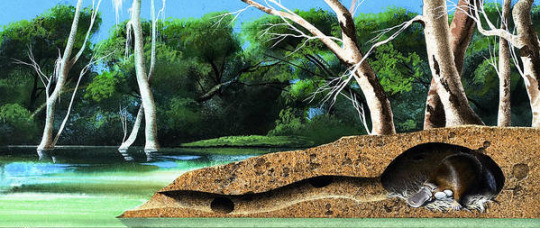
(image: a drawing of a cross-section of a platypus burrow. The burrow is located in a river bank with the opening right by the water. A long tunnel leads to a round chamber. In the chamber is a platypus with two eggs. Art by David Nockels)
Platypus mating season lasts between June and October every year. During this time, males will compete with each other for mates using their venomous spurs. Some males will maintain territories and force other males out while other males are more transitory and will go looking for mates. Females only mate with a single male every season. Strangely, females have two ovaries but only the left one is functional. After mating, the female will retreat to her burrow. While most egg-laying animals will lay they eggs as soon s they are formed, platypi retain their eggs internally for 28 days before laying them, after which they will continue to develop for 10 days before hatching. Most layings result in 2 eggs. The female curls around her eggs to incubate and protect them. Newborn platypi are called puggles and they are blind, hairless, and defenseless. As with other mammals, they feed on their mother's milk. Platypi do not have nipples and instead, the milk is secreted through the skin and into grooves on the mother's belly, where the puggles lap it up. While the puggles are developing, the mother spends less time out foraging, though she will increase the time foraging as her offspring develop. Weaning happes at 3-4 months, after which the juveniles will leave the burrow and set out on their own. Mothers have been observed laving behind soil plugs at the entrance to their burrows while there are offspring are in them. They are used to squeeze off water as the female returns to her burrow, preventing cold water from reaching the offspring.
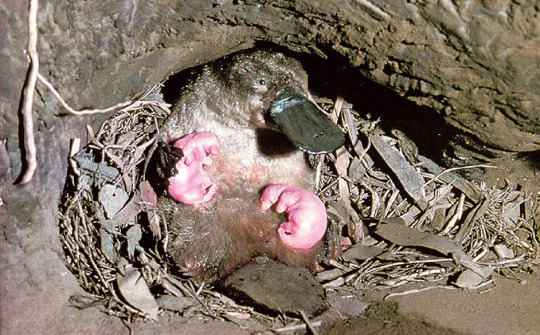
(image: a reconstruction of a mother platypus and puggles. They are in a dirt burrow lined with bits of leaves and bark. The mother is on its back and looking toward the camera. There are three puggles, which share the same body plan, but are very small and entirely pink. Tey are sitting on the mother's abdomen)
Platybi are classified as near threatened by the IUCN, though some argeu they should be reclassified as endangered. Their habitat range has decreased since European colonization of Australia and they are threatened by habitat loss, dams, pollution, and bycatch. Aboriginal Australians historically hunted them for food and Europeans also hunted them for fur, which was outlawed in 1912. The platypus was and is culturally relevant to Aboriginal peoples sharing its range, particularly the native peoples of the Murray river. There are multiple Dreamtime stories of the platypus, many dedicated to explaining how it ended up the way it is. In one, originating from the upper Darling river, a female duck named Daroo or was either seduced or kidnapped by a male water rat named Biggoon or Bilargun. After escaping, she laid two eggs that hatched into the first platypi, inheriting their mother's bill and webbed feet and father's body and fur. Another story from the same region says that the land animals, water animals, and birds all wanted the platypus to join their group and tried to convince it to join. The platypus decided that it didn't need to join any of the groups to be special, but still wanted to be friends with all of them and so took on traits from all groups.

(image: the Ironbarks Platypus, an Aboriginal Australian rock carving of a figure typically interpreted as a platypus. It is very simple, with a roughly rectangular shape with one rounded end. From one end is a simple loop usually interpreted as the platypus's bill. Four stick-like linbs emerge from the sides)
#wet beast wednesday#platypus#freshwater ecology#freshwater biology#biology#zoology#ecology#aquatic mammal#venomous mammal#amphibious mammal#monotreme#australia#animal facts
79 notes
·
View notes
Text
#MonotremeMonday :

Kordelia Zansui Chi (Australian, b. 1967)
Echidna, 1996
hand-colored linocut, 15 x 15 cm
#animals in art#20th century art#linocut#echidna#monotreme#Monotreme Monday#Australian art#Australian animals#Kordelia Zansui Chi#1990s
36 notes
·
View notes
Text

Short-beaked Echidna (Tachyglossus aculeatus), family Tachyglossidae, Mount Field National Park, Tasmania, Australia
Echidnas are also called "Spiny Anteaters"
Echidnas are monotremes, egg-laying mammals.
photograph by JJ Harrison
93 notes
·
View notes
Text

Stupid echidna face
28 notes
·
View notes
Text

Platypus with her baby
By: Warren Garst
From: The Fascinating Secrets of Oceans & Islands
1972
162 notes
·
View notes
Text

By Klaus - Flickr: Wild Platypus 4, CC BY-SA 2.0
35 notes
·
View notes
Text
Best Platypus Character Contest:
Enter your favorite platypus characters (anyone, but Perry)
They can be cartoons, ocs, platy-sonas, etc.
Enter your character into the Google Form linked below!

#perry the platypus#platypus#agent p#phineas and ferb#character#monotreme#best platypus character contest
66 notes
·
View notes
Text
I went to the zoo today and (among other things) saw flamingos (alas, his Lordship must have been in a secret tunnel, for they were all brightly colored), The Great God Om, and Dr. Horace Worblehat The Librarian.
I got a number of weird looks for cooing over various venomous reptiles and going “Aren’t you a sweetie? You’re so handsome!” in a babyish voice, but on the other hand I started singing a Gaelic song about the sea and two seals turned to look at me at the same time, which (to quote a certain angel who sauntered vaguely downwards) “was a thing”. Also: I saw an echidna (woo monotremes!), three sand cats (baby! Even if it’s an adult it’s a baby), and got to pet some rays and a ball python. All in all, I’d say it was a good day (except the heat and crowds).
#discworld#gnu terry pratchett#vetinari#havelock vetinari#lord vetinari#om#the gods#the librarian#seal(s)#pinniped(s)#gaeilge#gaelic#language#selkie#good omens#neil gaiman#crowley#reptile(s)#echidna#monotreme#sand cat#stingray#animals#snake#thought(s) from yours truly#zoo
89 notes
·
View notes
Text
Went to Healesville Sanctuary, Victoria, Australia.
Thought y’all would like the precious beans I saw today ;-;
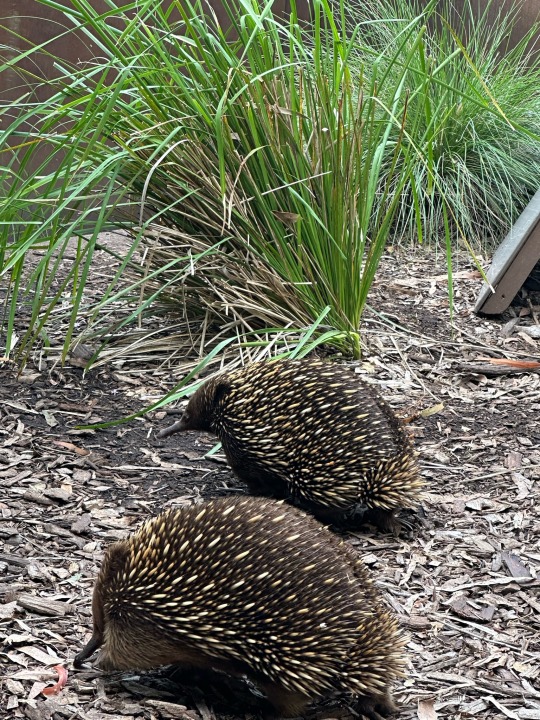




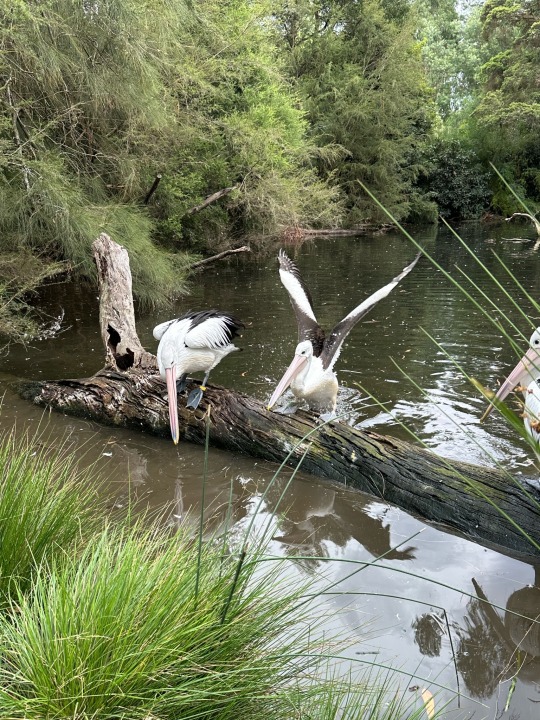




See below for animal IDs
Animals:
1 + 2 - Short Beaked Echidnas
3 - Red Kangaroos
4 - Eastern Grey Kangaroos
5 - Goodfellows Tree Kangaroo
6 - Australian Pelicans
7 - Boyd's forest dragon
8 - Rainbow Lorikeets
9 - Red-tail black cockatoos (female + male)
10 - Spinifex hopping mouse
#australian wildlife#animals#kangaroo#echidna#pelican#tree kangaroo#reptile#lizard#rainbow lorikeet#black cockatoo#mouse#hopping mouse#Aussie animals#Victoria#Melbourne#healesville sanctuary#wildlife#wildlife park#animal#animal sanctuary#aussie wildlife#zoo#marsupial#monotreme#Australian birds
13 notes
·
View notes